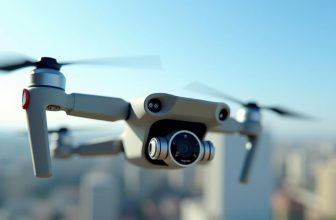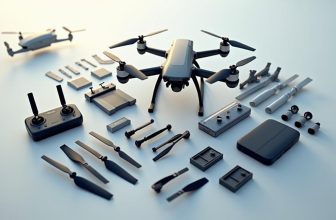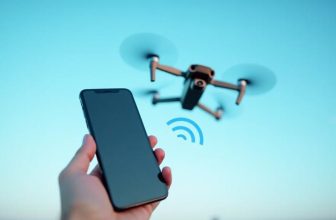
As you prepare to take to the skies with your DJI drone, you're probably eager to capture stunning aerial footage and photos. But before you can do that, it's essential to get a handle on the basics. You'll need to understand the different modes your drone offers, such as P-Mode and A-Mode, and master basic flight control techniques like pitch, roll, and yaw control. But what happens when you encounter obstacles or unexpected situations during flight? That's where things can get tricky – let's explore the key steps to ensure a safe and successful flight.
Contents
Key Takeaways
- Ensure your remote controller is fully charged and functioning correctly before flying.
- Master basic flight control techniques, including pitch, roll, and yaw control.
- Familiarize yourself with DJI drone modes, such as P-Mode for obstacle avoidance and GPS stabilization.
- Plan your flight route, checking for no-fly zones and utilizing weather forecasting tools.
- Inspect your drone for damage after landing and store it in a protective case or bag for optimal performance.
Pre-Flight Preparation Steps
Pre-Flight Preparation Steps
Your DJI drone's remote controller is your lifeline to a successful flight, so before you take to the skies, ensure it's fully charged and functioning correctly.
Also, make sure your drone's batteries are at optimal levels and the props are securely attached. Don't forget to register your drone with the relevant authorities, as required by law, to avoid any potential penalties.
It's also crucial to plan your flight route and check for any no-fly zones in the area.
Utilize weather forecasting tools to get an idea of the wind speed, direction, and precipitation in your area. This information will help you determine if it's safe to fly and choose the best time for your flight.
Review your drone's manual to familiarize yourself with its features and settings. Additionally, ensure you have the necessary spares, such as propellers and a charger, in case of an emergency.
Understanding DJI Drone Modes
With your drone and remote controller ready for flight, it's time to explore the different modes your DJI drone has to offer.
DJI drones come with multiple modes that allow you to customize your flight experience. You can switch between modes using the DJI Go app or the remote controller.
The most common modes are P-Mode (Positioning Mode), A-Mode (Attitude Mode), and S-Mode (Sport Mode).
P-Mode is ideal for beginners, as it provides obstacle avoidance and GPS stabilization.
A-Mode is used for more advanced flying, such as aerial photography and videography.
S-Mode is designed for racing and fast-paced flying.
Mode switching allows you to adapt to different flight scenarios and environments.
For example, you can switch to P-Mode when flying in a crowded area and switch to S-Mode when you need to capture fast-paced footage.
Flight customization is also possible through the DJI Go app, where you can adjust settings such as flight speed, altitude, and camera settings.
Understanding the different modes and customizing your flight settings will help you get the most out of your DJI drone and enhance your flying experience.
Basic Flight Control Techniques
Mastering basic flight control techniques is essential to flying your DJI drone safely and effectively.
You'll need to understand how to control the drone's pitch, roll, and yaw. The pitch refers to the up and down movement of the drone, while the roll is the left and right movement. Yaw is the rotation of the drone around its vertical axis.
To control the drone's movement, use the sticks on your remote controller.
The left stick controls the yaw and the throttle, while the right stick controls the pitch and roll. Practice moving the sticks in different directions to get a feel for how the drone responds.
When you're ready to land, reduce the throttle and descend slowly, then use the right stick to control the drone's descent and make a smooth landing.
As you become more confident in your flying skills, you can try more advanced maneuvers, such as drone tricks like flips and rolls.
These tricks require precise control over the drone's movement, but can be a fun way to challenge yourself and take your flying skills to the next level.
Now that you've got a feel for basic flight control techniques, navigating obstacles safely becomes a top priority.
To ensure a safe and smooth flight, understand the basics of obstacle avoidance on your DJI drone. Start by calibrating the sensors to ensure accurate readings. This process typically involves rotating the drone in a figure-eight pattern and following on-screen instructions.
Proper sensor calibration is crucial for obstacle avoidance systems to function effectively.
When flying, pay attention to the drone's obstacle avoidance system alerts. These alerts will notify you of potential collisions, and you should take immediate action to avoid them.
Be aware of your surroundings and keep an eye on the drone's flight path. If you're flying in a complex environment, consider using the drone's ActiveTrack feature, which allows the drone to track a subject while avoiding obstacles.
Remember to always follow safe flying practices and maintain a safe distance from obstacles.
Regularly update your drone's software to ensure you have the latest obstacle avoidance features and improvements. By combining sensor calibration, obstacle avoidance systems, and safe flying practices, you'll minimize the risk of collisions and ensure a successful flight.
Post-Flight Procedures Checklist
After landing your DJI drone safely, it's essential to complete a post-flight procedures checklist to ensure the drone's longevity and prepare it for the next flight.
Start by inspecting the drone for any damage or issues that may have occurred during the flight. Check for loose screws, damaged propellers, or other potential problems.
Next, you'll want to focus on battery care essentials. Remove the batteries from the drone and store them in a cool, dry place, away from direct sunlight.
Avoid overcharging or undercharging the batteries, as this can reduce their lifespan. Clean the battery contacts and ensure they're free from dust and debris.
For drone storage tips, store the drone in a protective case or bag to prevent damage. Keep the drone away from moisture and extreme temperatures.
Regularly update the drone's software and firmware to ensure you have the latest features and security patches. By following these post-flight procedures, you'll be able to extend the life of your DJI drone and ensure it's always ready for the next flight.
Regular maintenance is crucial for optimal drone performance.
Frequently Asked Questions
How to Update DJI Drone Software and Firmware?
You'll update your DJI drone's firmware by downloading the DJI GO app, connecting the drone, and following in-app prompts. Ensure software security by only using DJI's official site and understanding firmware basics before updating.
Can I Fly a DJI Drone Over Water?
When flying over water, you'll need to consider water landings and drone buoyancy. You can fly DJI drones over water, but ensure they're waterproof or have a flotation device, and set a safe landing spot in case of emergency.
Do I Need Drone Insurance for Recreational Use?
Ironically, you're probably thinking "nothing will go wrong" – but accidents happen. For recreational drone use, you'll want to consider insurance to protect your personal assets from potential drone liability and financial losses.
How to Back up DJI Drone Flight Data?
You'll want to back up your drone's flight data regularly for Data Protection and Flight Recovery purposes. Use DJI's Go app or third-party software to sync and store flight logs, images, and videos on your device or cloud storage.
Can I Customize DJI Drone With Third-Party Accessories?
Imagine upgrading your drone's style and performance. You can customize your DJI drone with third-party accessories, such as custom propellers for enhanced aerodynamics and LED lights for increased visibility, with caution and compatibility checks.
Conclusion
You've landed safely, and your maiden flight with a DJI drone is a success. As the propellers come to a stop, you feel a sense of accomplishment, knowing you've mastered the basics. The drone's sleek design and your steady hands have made for a seamless flight. With every takeoff and landing, your skills will soar. Now, it's time to review and refine your techniques, ready to take on new adventures and push the limits of aerial photography.






